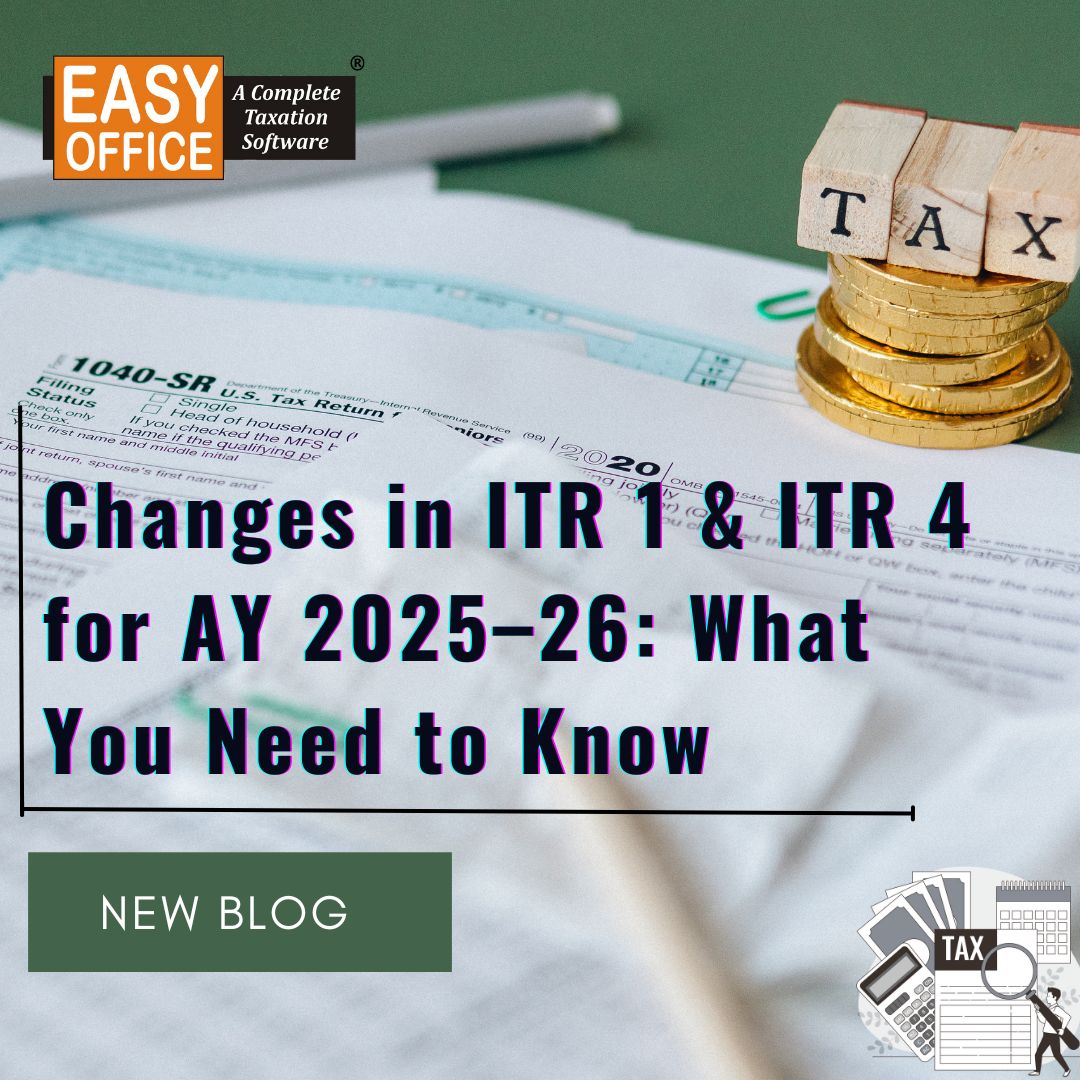Updated Returns: Purpose, Eligibility and Filing Process

Updated Returns: Purpose, Eligibility and Filing Process
An integral part of filing Income Tax Returns (ITR) is double-checking whether every detail submitted is correct and backed by document proof. As we know that mistakes in ITR filing can be costly, we must take every caution to avoid them, including checking the instructions and learning about the ITR process beforehand. But what if you’ve filed returns with mistakes?
Fortunately, there are quite a few remedies that the authorities offer to taxpayers to let them correct genuine mistakes. One of them is the option to file updated returns. This facility allows taxpayers to rectify their mistakes and avoid legal actions taken by the tax department.
Here we will discuss everything you need to know about filing updated returns.
What Is Updated Returns?
An updated return is a relatively new type of Income Tax Return (ITR) that allows taxpayers to rectify their mistakes. With this facility, taxpayers who made mistakes in their previously filed ITR or failed to file an ITR can file an updated return. Taxpayers need to abide by specific timelines to file these returns. They must pay additional taxes, interest, and penalty for late filing.
The Union Budget 2022 introduced the concept of updated returns by including the new Section 139 (8A) and Section 140B in the Income Tax Act. On 29th April 2022, the Central Board of Direct Taxes (CBDT) introduced Form ITR-U and Rule 12AC for filing an updated return of income. The measure was taken to increase voluntary compliance of taxpayers who might otherwise hesitate to declare omissions and mistakes.
When Do You Need to File Updated Returns?
Filing the ITR-U is optional and the right to file it is given to every person. In other words, anyone can file it to rectify a mistake or an omission or to file an original return for a particular assessment year. However, one must file updated returns via ITR-U within 24 months from the end of the relevant assessment year.
The following table shows the timeline for submitting updating returns:
| Assessment Year | Last Date of Filing Updated Returns |
| AY 2020-21 | 31st March 2023 |
| AY 2021-22 | 31st March 2024 |
| AY 2022-23 | 31st March 2025 |
| AY 2023-24 | 31st March 2026 |
Who Can File Updated Returns via ITR-U?
As mentioned above, any person can file an updated return unless it is for specified reasons. Individuals, HUFs, firms, companies, AOP, BOI, etc., are all eligible to file this document. Moreover, it can be filed for original returns, revised returns and belated returns.
Taxpayers can also file an ITR-U for themselves and for any person they are representing for taxation purposes. One can file an updated return even for a return of loss filed under Section 139 (3), except for a case where the updated return is a return for losses.
As a taxpayer, you will need to fulfil the following parameters of eligibility for updated returns via ITR-U:
- It can be filed only if you have to declare any additional income that you did not include in a previously filed return. The return must result in additional tax liability.
- You can file the return if you have not filed the income tax return earlier or made omissions/errors in the original ITR.
Who Cannot File Updated Returns via ITR-U?
You cannot furnish updated returns u/s 139 (8A) if the following conditions are fulfilled:
- The updated return result in a refund or increases the refund amount you previously received
- A search under Section 132 has been initiated against you for the previous financial year
- The updated return that you’ve filed shows a net loss
- A survey under Section 133A is being conducted against you for the previous financial year or any year before
- Documents or assets like cash, jewellery, bullion or any other valuable article have been seized by the Income Tax Department
- Books of accounts or other documents have been requisitioned u/s 132A
- You have already filed an updated return once
- The Assessing Officer has received information about you regarding the Tax Information Exchange Agreement (TIEA) or Double Taxation Avoidance Agreement (DTAA)
- You also cannot file updated returns for a year in which revision, recomputation, reassessment or assessment is pending
- Your updated return decreases your total tax liability
- Legal proceedings have been initiated by a prosecutor for the relevant assessment year
- Other cases notified by CBDT
How to File Updated Returns via Form ITR-U?
Follow the given steps to file your updated returns:
Step 1: Log in to the official income tax e-filing portal.
Step 2: Navigate to ‘e-File’ on the top menu. Then, click on ‘Income Tax Returns’> ‘File Income Tax Returns’.
Step 3: From the given drop-down menus, select the relevant assessment year and choose ‘Filing Type’ as ‘139(8A) Updated Return’.
Step 4: Furnish the required information in the ITR-U form. This form has two parts-
1) Part A- for general information regarding ITR filing and
2) Part B- for computation of updated total income and tax.
Step 5: Upload the offline JSON file to submit your returns. Note that you will need to submit an updated version of an ITR form (1 to 7) along with ITR-U.
Step 6: You need to use either a Digital Signature Certificate (DSC) or Electronic Verification Code (EVC) to file the update return.
What Are the Penalties for Filing Updated Returns?
As updated returns can be filed only after the end of each relevant assessment year, there are always some penalties and taxes applicable to it. Section 140B provides the provisions for the computation of fees, interest and taxes applicable to updated returns. The following are all the applicable payments for these returns:
- When ITR was not filed previously:
If you did not file tax returns for the relevant assessment year, you need to pay the tax payable and additional tax. Along with this, you need to pay a fee for delay in filing return u/s 234F and interest on self-assessment tax u/s 234A, interest on assessed tax u/s 234B and interest on the shortfall of advance tax u/s 234C.
- When ITR was filed previously:
In this situation, you also need to pay your due taxes and additional tax along with late filing fees u/s 234F and interest on delay in payment of advance tax. The amount will be reduced by the interest paid in the earlier return. Furthermore, any amount refunded will be added to the tax amount.
The following table shows the additional tax you will have to pay on income reported to be missing:
| Updated Returns Filed | Additional Tax Payable |
| After the due date of filing revised/belated ITR but before 1 year from the end of the relevant AY | 25% of the aggregate tax and interest u/s 234A, 234B and 234C (plus surcharge and cess) |
| After one year from the relevant AY but before 2 years from the relevant AY | 50% of the aggregate tax and interest u/s 234A, 234B and 234C (plus surcharge and cess) |
Bottom Line
The Government of India has introduced new facilities like updated returns to increase tax compliance in the country. The option to file updated returns allows taxpayers to make corrections to their previously filed returns for up to 2 years from the relevant assessment year.
If you find it hard to keep track of the due dates for advance taxes and other liabilities, why not take the help of EasyOffice, the best ITR filing software in India? It is complete taxation software that takes care of all your tax filing and challan payment needs.
Frequently Asked Questions
- How many times can you file an updated return?
You can file an updated return only once for any relevant assessment year. This return form is only meant to provide one last chance for taxpayers to make corrections voluntarily
- How much additional tax do you have to pay for an updated return?
You can file an updated return only once for any relevant assessment year. This return form is only meant to provide one last chance for taxpayers to make corrections voluntarily.
- How much additional tax do you have to pay for an updated return?
If you file an updated return, you have to pay additional tax at a 25% or 50% rate of the total tax amount paid. The former rate applies when the updated return is filed 12 months from the end of the particular assessment year. The latter tax rate applies after the expiry of 12 months from the assessment year.
- What are the valid reasons for which you can file updated returns?
You can file updated returns u/s 139 (8A) and 140B for the following reasons only: Reducing carried forward losses, reducing tax credit u/s 115JB/115JC, not filing ITR previously, choosing the wrong head of income, choosing the wrong rate of tax or for declaring undisclosed income.
- Can you claim a refund by filing an updated ITR?
No, the only time you can file an updated ITR is when you are not claiming refunds or additional refunds.
- What is the due date to file an updated return for AY 2022-23 and AY 2023-24?
For AY 2022-23, the last date to file an updated ITR via the ITR-U form is 31st March 2025 and for AY 2023-24, its 31st March 2026.












